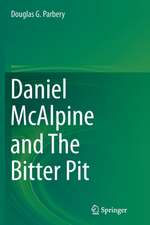Neuroscience – A Historical Introduction: The MIT Press
Autor Mitchell Glicksteinen Limba Engleză Paperback – 25 sep 2017
This introduction to neuroscience is unique in its emphasis on how we know what we know about the structure and function of the nervous system. What are the observations and experiments that have taught us about the brain and spinal cord? The book traces our current neuroscientific knowledge to many and varied sources, including ancient observations on the role of the spinal cord in posture and movement, nineteenth-century neuroanatomists' descriptions of the nature of nerve cells, physicians' attempts throughout history to correlate the site of a brain injury with its symptoms, and experiments on the brains of invertebrates.
After an overview of the brain and its connections to the sensory and motor systems, Neuroscience discusses, among other topics, the structure of nerve cells; electrical transmission in the nervous system; chemical transmission and the mechanism of drug action; sensation; vision; hearing; movement; learning and memory; language and the brain; neurological disease; personality and emotion; the treatment of mental illness; and consciousness. It explains the sometimes baffling Latin names for brain subdivisions; discusses the role of technology in the field, from microscopes to EEGs; and describes the many varieties of scientific discovery. The book's novel perspective offers a particularly effective way for students to learn about neuroscience. It also makes it clear that past contributions offer a valuable guide for thinking about the puzzles that remain.
Din seria The MIT Press
-
 Preț: 155.83 lei
Preț: 155.83 lei - 16%
 Preț: 661.59 lei
Preț: 661.59 lei -
 Preț: 128.67 lei
Preț: 128.67 lei -
 Preț: 229.64 lei
Preț: 229.64 lei -
 Preț: 168.59 lei
Preț: 168.59 lei - 14%
 Preț: 437.85 lei
Preț: 437.85 lei - 20%
 Preț: 336.15 lei
Preț: 336.15 lei -
 Preț: 102.29 lei
Preț: 102.29 lei -
 Preț: 107.35 lei
Preț: 107.35 lei - 20%
 Preț: 151.20 lei
Preț: 151.20 lei -
 Preț: 90.17 lei
Preț: 90.17 lei -
 Preț: 152.90 lei
Preț: 152.90 lei -
 Preț: 178.98 lei
Preț: 178.98 lei -
 Preț: 174.49 lei
Preț: 174.49 lei - 17%
 Preț: 599.95 lei
Preț: 599.95 lei - 17%
 Preț: 533.17 lei
Preț: 533.17 lei - 19%
 Preț: 123.87 lei
Preț: 123.87 lei -
 Preț: 203.41 lei
Preț: 203.41 lei - 16%
 Preț: 1201.02 lei
Preț: 1201.02 lei -
 Preț: 137.51 lei
Preț: 137.51 lei -
 Preț: 252.85 lei
Preț: 252.85 lei - 16%
 Preț: 637.28 lei
Preț: 637.28 lei - 12%
 Preț: 92.10 lei
Preț: 92.10 lei - 12%
 Preț: 523.07 lei
Preț: 523.07 lei - 20%
 Preț: 284.80 lei
Preț: 284.80 lei -
 Preț: 241.46 lei
Preț: 241.46 lei -
 Preț: 113.45 lei
Preț: 113.45 lei -
 Preț: 181.74 lei
Preț: 181.74 lei - 20%
 Preț: 338.95 lei
Preț: 338.95 lei -
 Preț: 290.07 lei
Preț: 290.07 lei - 16%
 Preț: 539.05 lei
Preț: 539.05 lei -
 Preț: 193.63 lei
Preț: 193.63 lei -
 Preț: 362.12 lei
Preț: 362.12 lei -
 Preț: 174.42 lei
Preț: 174.42 lei -
 Preț: 286.73 lei
Preț: 286.73 lei -
 Preț: 168.64 lei
Preț: 168.64 lei - 13%
 Preț: 96.18 lei
Preț: 96.18 lei - 20%
 Preț: 144.96 lei
Preț: 144.96 lei - 20%
 Preț: 127.07 lei
Preț: 127.07 lei - 14%
 Preț: 93.51 lei
Preț: 93.51 lei -
 Preț: 331.92 lei
Preț: 331.92 lei -
 Preț: 208.78 lei
Preț: 208.78 lei -
 Preț: 238.73 lei
Preț: 238.73 lei -
 Preț: 255.59 lei
Preț: 255.59 lei - 33%
 Preț: 126.59 lei
Preț: 126.59 lei -
 Preț: 366.77 lei
Preț: 366.77 lei -
 Preț: 175.42 lei
Preț: 175.42 lei -
 Preț: 250.93 lei
Preț: 250.93 lei -
 Preț: 252.58 lei
Preț: 252.58 lei -
 Preț: 115.25 lei
Preț: 115.25 lei
Preț: 368.09 lei
Nou
70.44€ • 73.13$ • 58.74£
Carte tipărită la comandă
Livrare economică 22 martie-05 aprilie
Specificații
ISBN-10: 0262534614
Pagini: 418
Dimensiuni: 153 x 229 x 22 mm
Greutate: 0.73 kg
Editura: Mit Press
Seria The MIT Press
Descriere
An introduction to the structure and function of the nervous system that emphasizes the history of experiments and observations that led to modern neuroscientific knowledge.This introduction to neuroscience is unique in its emphasis on how we know what we know about the structure and function of the nervous system. What are the observations and experiments that have taught us about the brain and spinal cord? The book traces our current neuroscientific knowledge to many and varied sources, including ancient observations on the role of the spinal cord in posture and movement, nineteenth-century neuroanatomists' descriptions of the nature of nerve cells, physicians' attempts throughout history to correlate the site of a brain injury with its symptoms, and experiments on the brains of invertebrates.After an overview of the brain and its connections to the sensory and motor systems, Neuroscience discusses, among other topics, the structure of nerve cells; electrical transmission in the nervous system; chemical transmission and the mechanism of drug action; sensation; vision; hearing; movement; learning and memory; language and the brain; neurological disease; personality and emotion; the treatment of mental illness; and consciousness. It explains the sometimes baffling Latin names for brain subdivisions; discusses the role of technology in the field, from microscopes to EEGs; and describes the many varieties of scientific discovery.
The book's novel perspective offers a particularly effective way for students to learn about neuroscience. It also makes it clear that past contributions offer a valuable guide for thinking about the puzzles that remain.






















